How To Climb Offwidths 101
- December 2009
- Climb
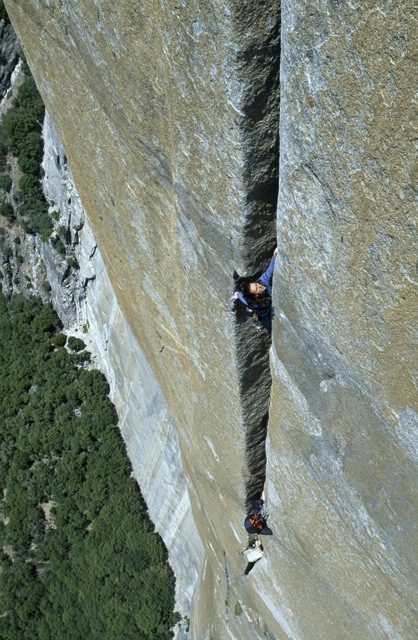
Hi Steph,
I am a novice crack climber since moving to a city close to Joshua Tree.
While living in Utah I never really got into crack climbing despite being
only a couple hours from IC. I have found your posts on crack climbing to be
the best on the web. However, I am hungry for more information on crack
climbing. My wife and I are climbing low 5.10 cracks and struggling with
finding more info. We only get to climb about once a week because of work
and three young kids, but when we go we like to climb crack.
I would be interested in off-width advice if you have any. If you know of a
book on crack climbing that actually works, or if you know things to
practice (or other internet sites) that would all be helpful. Thanks for all
that you contribute to climbing.
Very Respectfully,
Stan
Dear Stan,
Thanks for writing! Offwidths are really not as awful as they first seem. In fact, the great thing about them is that they are only about technique. Once you’ve gotten the techniques down, they go from impossible and horrific to actually enjoyable, and not very strenuous.
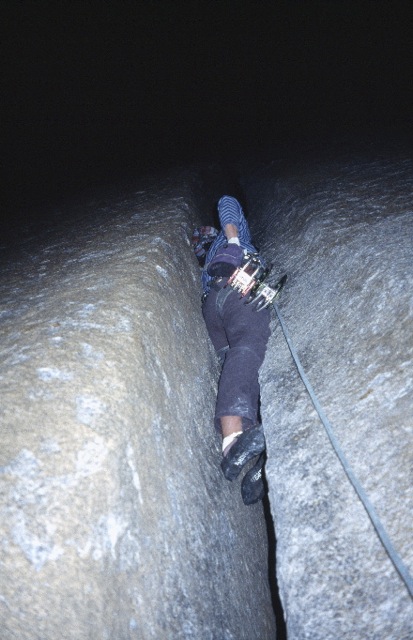
So as with everything, offwidths are all about the feet. I have good news or bad news, depending on what size you are: the bigger your feet, the easier it will be to climb wide cracks. If you are climbing sandstone offwidths, which tend to have less small footholds and little edges, I strongly recommend you wear Five Tennies for wide cracks. It makes it way easier, and more comfortable. On granite, where you need to take advantage of anything you can get, just wear a big, stiff shoe. I use Anasazi Laceups (in a big size), which are normally a little on the too-stiff side for me. Also, if you aren’t going to wear thin socks, tape your ankles!!! These tips alone will instantly make offwidths far more enjoyable. And easier.
But as I said, it’s all about the feet. Get your footwear organized, and when you approach the wideness, think about camming your feet into the crack. Wedging your heel and toe inside the crack, or cammed against the outside edge, works incredibly well. Once you have this down, and if your foot happens to be the right size for the particular crack, you will suddenly find that you have to do very little with your arms and hands except hold yourself in place as you walk your feet up. It’s an amazing thing.
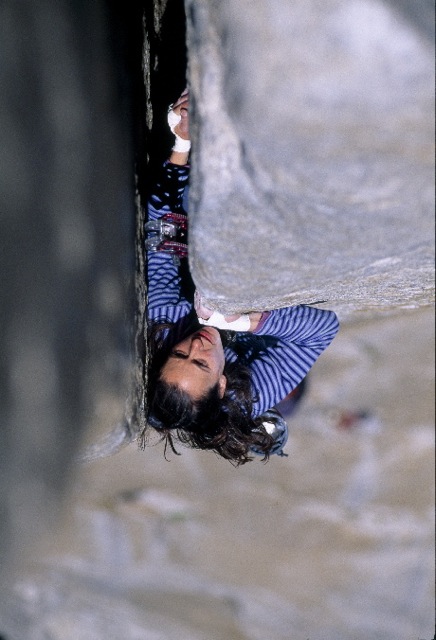
The general technique for offwidths is wiggling and wedging. Get your feet wedged in there, and then do whatever you need to do with your upper body to make it stick in order to move your feet up again. On granite, there are often small edges in and around the crack. Use these as much as possible. Also, don’t forget to reach inside the crack as deep as you can, because sometimes they taper inside and you can actually get a fist jam. Again, the bigger you are, the happier you will be, because you are more likely to squeeze a fist jam out of the crack. If there is a fist jam back there, use that and forget about the offwidthing. If there’s not a fist jam back there, don’t flail around wishing there was. Instead, use your wide technique….
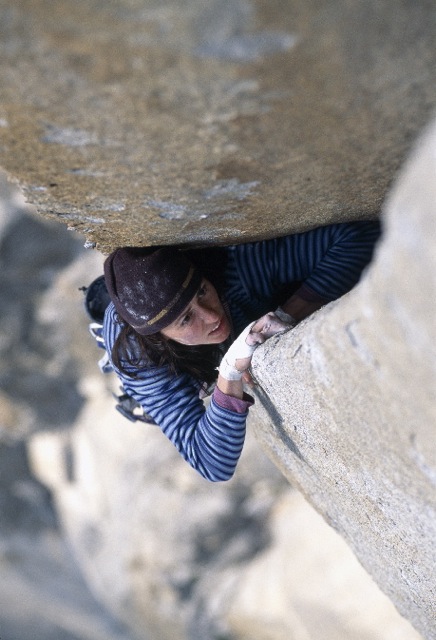
Chicken winging works great. Wearing a thick, fuzzy shirt makes it work even better.
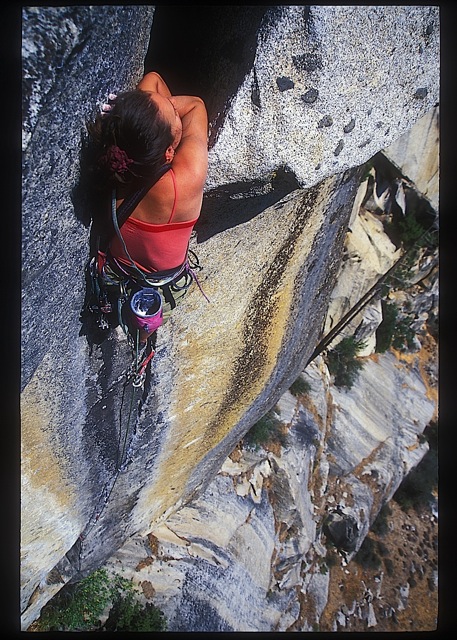
Chicken winging also works with bare skin, but it’s not recommended 🙂 .
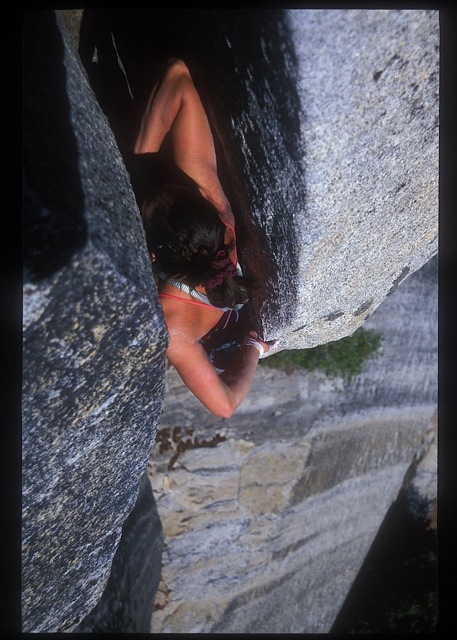
Chicken winging is the most basic arm bar for wide cracks, but you want to wiggle around and do whatever works. Basically anything you can do inside or outside the crack that makes you stick, is what you want to do. Don’t get hung up on wanting a solid jam feeling. Fist stacking and hand/fist jamming are great. Chicken winging is great. Finding a little edge to crimp on is great. Wedging both shoulders or inhaling to make your chest stick is great. Basically, as long as you don’t panic and you are willing to be creative, like a little kid, you are going to find a way to make your upper body stick in the crack long enough to step up your feet and get them cammed and stuck in the next section.
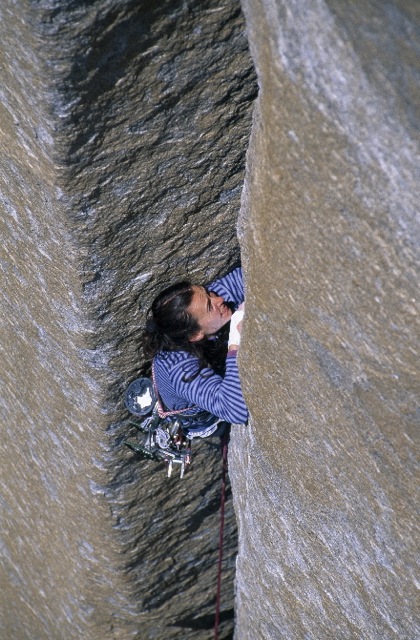
I think the biggest thing with offwidths is to remain calm and be patient. It’s actually harder than it seems to actually fall out. And it will take much longer to move up than in, say, a hand crack. If you remain calm and don’t thrash around, you will find it’s actually not very strenuous. It’s okay to take twice as long to go half as far, as long as you don’t get yourself all exhausted. That’s part of the deal with wide cracks.
So the best way to start is to hang a toprope on a likely looking offwidth, and spend some time trying all of these things. You will be surprised at how quickly it goes from impossible to actually pretty fun….make sure to bring the kids along to lend you their attitude of limitless creativity.
I hope this helps a little!
🙂 Steph








Awesome advice, wish i had read this a year ago before learning the hard way on sandstone at the red. Wearing the right clothing was definitly my first lesson…on sandstone had both shoulders wedged in and a foot chip poped…good bye shoulder skin
Hey Steph,
u r the best, amazing explanation,
I like this post because I can relate to large off widths not being as hard as people might think. One day at Horseshoe Canyon in Arkansas it was pouring down rain but we still wanted to climb so decided to head to an overhanging area and mess around on a hard sport climb, but when we got there we saw this beautiful off with crack/chimney thing.
My friend had been dying to climb a crack in that area but upon looking at it he turned to me and said, “your leading it right”. At first I thought no way, the book says it’s a 5.9. But after looking at a few more seconds I was committed.
What seemed like an hour later I was at the top of the route with a full rack of gear sewing up the crack. It felt good to lead something that hard even if it took FOREVER. But as you said if you don’t thrash around you will be alright, and it was really hard to fall out. All our group finished it on TR just fine.
Hi Steph, good to see such an inspiring climber giving such pertinant advice! I just went to Yosemite for a winter trip, got on reeds direct especially for the wide top section. My first 5.10 offwidth. For some reason, I’ve been drawn to the wide lately and getting up that climb felt so good. Just wanted to encourage those who read this to persevere and keep at it, eventually it just works!
Hi Steph,
My husband chose an offwidth in Eldo to climb this week and I went into instant panic mode. I’m a happy slab climber any day! Your post helped me relax a bit and I have huge feet so I’m finally glad to put them to good use:-D
Thank you for the great explanation and photos!
Annette
[…] great source of information is Steph Davis’s climbing blog. She’s got some great pictures on there, […]
[…] you want to imagine yourself up on a crag, perhaps start here. (An “offwidth” is apparently a vertical crack that’s too wide to use one common […]
[…] Jose! Here is a link to some offwidth info I wrote a while back. And this is a general crack climbing article I wrote some years back that […]
Michael’s Belay Glasses: http://belayglass.blogspot.com/ Don’t crane your neck while belaying. Wear these glasses and look forward to gaze upward saving on neck strain. They allow the belayer to more fully concentrate their attention to the task at hand, especially on long, protracted sessions. They accomplish this at roughly a 1/4 of the cost of the other product on the market, putting this easier into the average climbers budget.
Hi Steph or whoever,
Quick question. I find off-width climbing is super hard at the #4 BD point. This is the point where the crack becomes just to wide to foot jam, but it is still to thin to get enough angle to make the toe-heel jam work. Any tips?
yep, it’s a terrible size. make sure to tape your ankles, and/or wear socks
Yea, I went out the day after that comment and tried tape on the ankles (and did an extra burly wrap on the hands). It went a long way to helping me keep my foot/calf in long enough to shift my butterfly jams. By the end of the day we cleared 3 classic Squamish off-widths.
It’s funny how just a little extra tape and a little adjustment to technique can go such a long way.
success!
What route?
Having a thigh the right size helps with those. It’s the only time all that extra muscle bulk comes in handy for me. What I really have trouble with is the size right outside of squeeze chimney. To narrow to stem but too fat to ass jam. I have to go back and forth between camming my upper and lower body and basically inch worming my way up.
Ha, a year later and now this size is easy for me. Now the only thing that gives me troubles is flares in the 4-5 range and even those I’m getting better at.